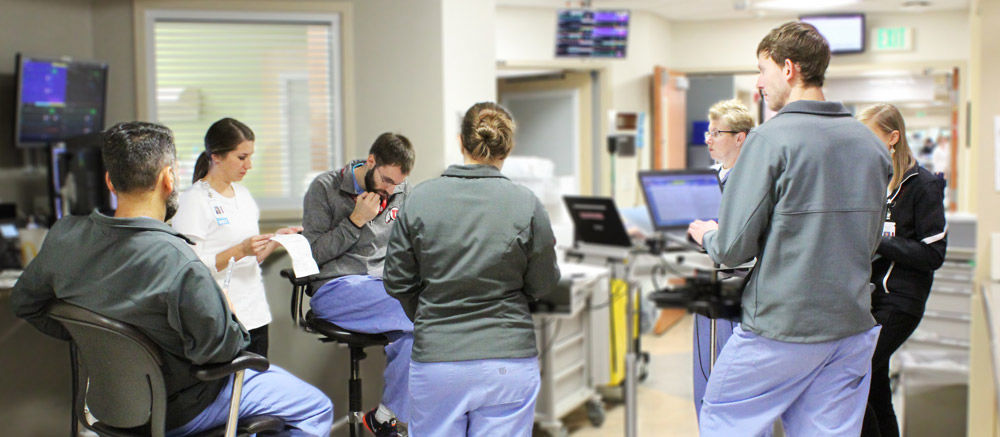partnership with physicians, Desiree Dougherty, the nurse manager of the Surgical Intensive Care Unit (SICU), changed the pattern of physician rounds. Physician rounds are a mainstay of life in the inpatient setting. Each physician service rounds on their patients, usually in the morning. A team of up to 10 physicians, trainees, and pharmacists visit each patient to share information and set the plan for the day–tests, surgeries, possible discharge. The centerpiece of rounds is the trainee’s presentation. The trainee closely cares for the patient, and presents the patient’s case to the rounding team to demonstrate their aptitude and decision making. Traditionally, the patient’s nurse may not be present. SICU changed their rounding format so that the nurse is not only in the room, but also presents the patient’s case to the rounding team. Accelerate’s Mari Ransco and Value Engineer Mitch Cannon spoke with Desiree (Dez) Dougherty and Liz Eshleman to find out why and how it works.
Want to adapt the form for your team? Download it now.
PDF | Word Doc
New nurses are taught by example. When they are new to SICU, they verify information to lessen interruptions and flow. When the new nurse is ready to present, the team coaches them to report the information and not interject with opinions. Consistency in the form and in the presentation makes rounding more efficient.
Using a form
Our physicians round in the morning. We have a form that guides the conversation. We set it up so that it was very methodical, designed to answer the physicians’ questions. The doctors don’t want to hear all the extracurricular events that happen during routine care – their focus during rounds is on diagnosis and treatment. The form helps us keep it very black and white.
Creating a real team with physicians
It changed the team dynamics. The nurse presentation taught the physicians to slow down and to listen to the nurses. It reinforced that the nurse is the source of real-time information on the patient. For example, sometimes the residents get so busy they haven’t had time to go into the room with a stethoscope, and they say things like, “Well, I think the lungs…wait, how do the lungs sound?” Their information comes from a note that may be a few hours old, not from a real-time assessment. The nurse has the most up to date information. It really helped the physicians learn from the nurse.
Empowering nursing through practice
Initially, I think the nurses were nervous to do the presentation. 80% of our staff has less than 5 years ICU experience. It’s really intimidating to be a nurse here. There’s ten people at rounds, and all of them are experts. When you’re the one talking about the patient, you really need to know your stuff. What we present must be accurate and consistent.
You also have to use your loud voice so everyone can hear! Before, the doctors could be teaching, and the nurse could sneak out the back and do some stuff in her other patient’s room. Now, the nurse has to physically stop and engage. Rounds don’t start without the nurse.
It’s really helped the nurses hone their practice. No nurse wants to stand in front of a physician and not know the answer to their question. They feel passionate about knowing about each patient. As an ICU nurse, they’re expected to know the details.
We helped the nurses structure the presentation and present in the way that doctors think. It really helps the nurses deeply understand what is happening with each patient and then communicate more effectively with the family.
Increasing nursing teamwork
We wanted to include night shift into the rounding process. The night staff fills out the rounding sheet because the night staff knows what has happened right before rounding. The morning nurse completes the rounding sheet and then presents the team’s work to the physicians. It was so important to include everyone. It really helped bridge the gaps between shifts.
It helps the day nurse prioritize which tests need to happen before rounds. The day nurse might see that the last blood gas was done at 2 a.m., so I need to write down the most current results.
It’s also increased ownership. You really have to trust that the person on night shift is filling out the form. If anything is missing, our nurses will often hold each other accountable. “I noticed you didn’t add your volumes, or hey, did you notice that there was a flaw in the sheet?” We’re a better team now because of changing rounds.
Desiree (Dez) Dougherty
Liz Eshleman
Rounding–the act of connecting with patients and staff–is a leadership best practice. While few find rounding easy to start, those who master it are hooked. It is a daily habit that improves patient care, experience and engages the team. Susan Clark and her medical director, Dr. Dana DeWitt, have taken the practice one step further by rounding together as a leadership dyad, resulting in a more connected and authentic team.
Learners, patients, and teachers are more confident and inspired when we take time to create positive learning environments. Pediatric endocrinologist Kathleen Timme gives practical advice for integrating key aspects of a positive learning environment into your daily interactions.
As the director of nursing at Huntsman Cancer Hospital, Sue Childress shares her passion for improvement with a team of hundreds of nurses and HCAs. Learn how a cape and hat inspired Childress’ nursing career, and a passion for cultivating innovation.
